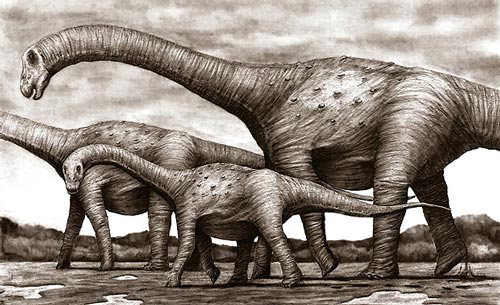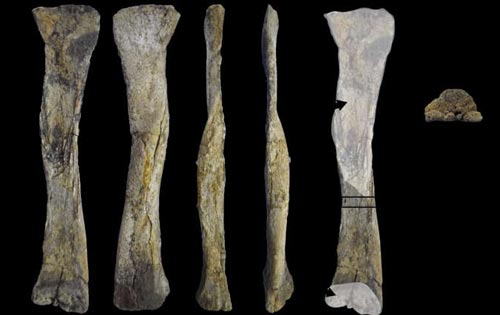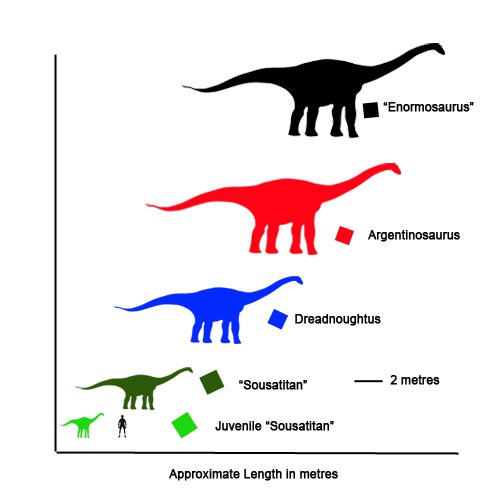A New Brazilian Titanosaur (Most Likely)
“Sousatitan” from North-eastern Brazil
All eyes might be on the likes of Usain Bolt, Jason Kenny, Nicola Adams et al at the Rio Olympic Games, but today, Everything Dinosaur turns its attention to another part of Brazil, an area some two thousand kilometres (1,200 miles) further north. The discovery of a single dinosaur leg bone has provided scientists with an insight into the growth and development of the biggest type of land animal to ever have lived – a titanosaur.
Titanosaur Fossil Discovery
An Illustration of a Group of Titanosaurs
Picture credit: Marcos Paulo
The Sousa region in Paraiba State is famous for its extensive dinosaur trackways, however, actual bones are few and far between in the so called “Valley of the Dinosaurs”. Thanks to the sharp eyes of local resident Luiz Carlos Gomes, the fibula (part of the lower leg), of a giant long-necked dinosaur has been excavated and studied by an international team of scientists. Luis spotted the pieces of bone eroding out of a rock face and posted a photograph of his find on line. Palaeontologists were soon alerted and the fossil fragments were carefully removed and pieced together.
A New Species of Titanosaur
The bones most likely represent a new species of titanosaur. For the moment, the animal has been nick-named “Sousatitan”, but sadly, unless more fossils are found, it is likely that this single bone will not lead to a formal scientific description and the erection of a new species of Brazilian dinosaur.
The scientists including palaeontologist Aline Ghilardi (Federal University of Pernambuco), report in the journal “Cretaceous Research”, that the fossil find is the first dinosaur bone to be found in the Rio do Peixe basin complex and that the strata in which the bone was found dates from the Early Cretaceous, indicating that titanosaurs roamed this part of north-eastern Brazil around 136 million years ago.
Extensive, wide- bodied trackways found in this region had been attributed to titanosaurids, but this fragmented lower leg bone is the first body fossil to indicate the presence of dinosaurs in this part of Gondwana.
Various Views of the Titanosaur Fibula
The Earliest Stratigraphic Occurence of Titanosauria in Brazil
“Sousatitan” represents the oldest titanosaur bone found in Brazil and the scientists are hopeful that more material can be found to help them discover more about the sort of herbivorous dinosaurs that roamed central Gondwana during the Berriasian to the Valanginian faunal stages of the Early Cretaceous. With the assistance of other researchers from the University of Cape Town, the team were able to establish that the leg bone came from a juvenile.
Analysis of the bone micro-structure taken from mid point in the fibula revealed that the bone came from a young animal, one that had been through a burst of growth but had not yet reached adult size. The scientists estimate that this individual was around 5.7 metres in length and around 1.6 metres high at the hip when it died. It is likely that as an adult, this dinosaur would have been much bigger. Trace fossils (trackways) in the Sousa area suggest titanosaurs more than sixteen metres long.
Size Comparison of Different South American Titanosaurs
For dinosaur and prehistoric animal figures: Dinosaur and Prehistoric Animal Models.
A Juvenile Titanosaur
Picture credit: Everything Dinosaur
Palaeobiologist, Professor Anusuya Chinsamy-Turan (University of Cape Town) analysed the well-preserved, fossilised bone micro-structure of the animal and was able to conclude that the bone was from a juvenile.
She commented: “When I studied the bone micro-structure under the microscope, it was clear that the bone belonged to a juvenile titanosaur. The bone structure had features that indicated that the animal was still a fast-growing young individual and that it had died before it had reached full body size.”
For the moment “Sousatitan” might not be quite as familiar to Brazilians as Usain Bolt, Mo Farah or even their own gold medal winner from the track, Thiago Braz da Silva, but perhaps one day in the future, more fossils will be found and this part of north-eastern Brazil will have a newly described titanosaur to call their own.
Visit Everything Dinosaur’s website: Everything Dinosaur.




